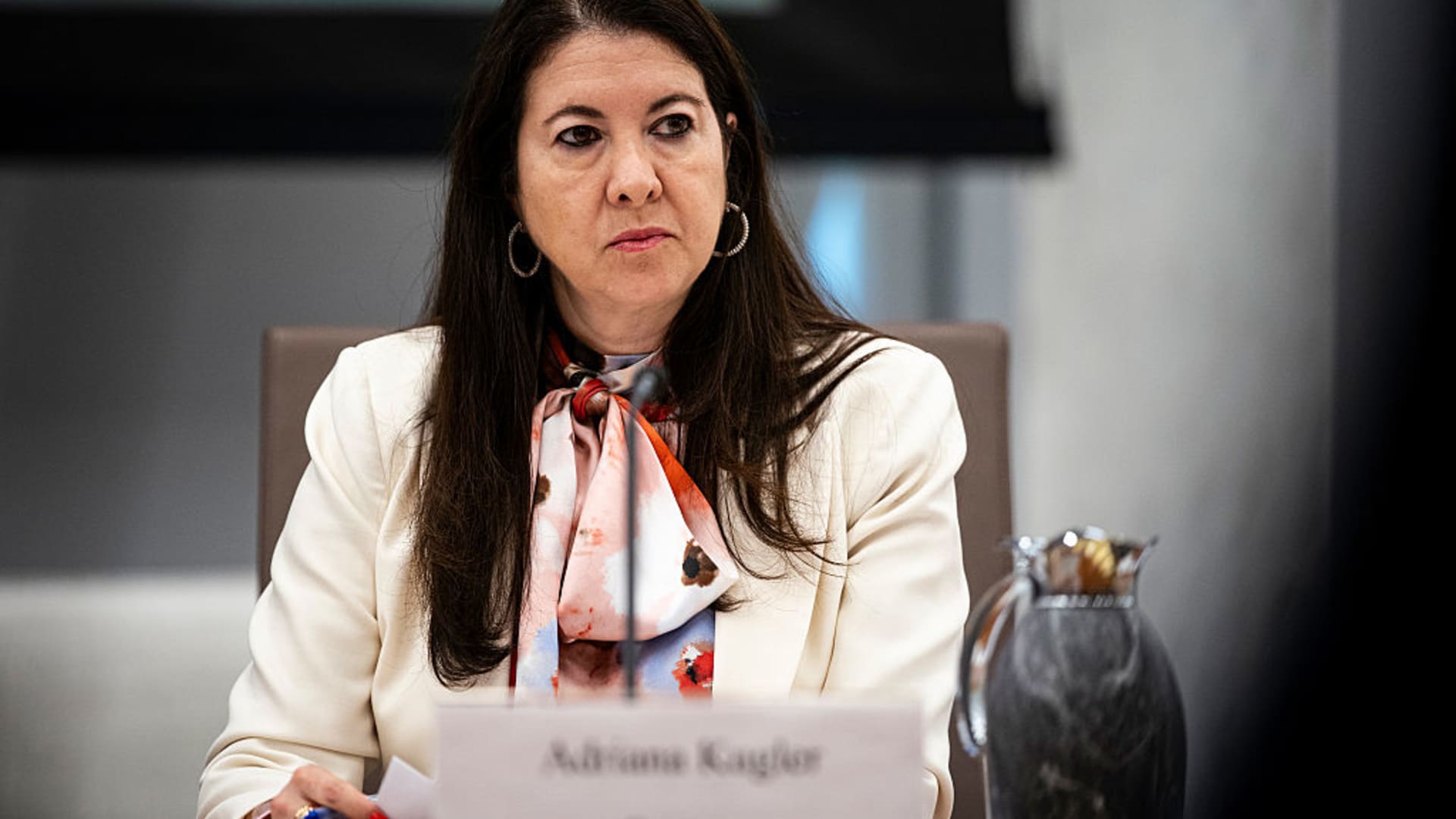
Former Federal Reserve Governor Adriana Kugler’s abrupt resignation from the board on Aug. 1 – and her unexplained absence at a key meeting two days earlier – left the financial community shocked and confused.
Nominated by Democratic former President Joe Biden to fill a surprise vacancy on the Fed board and confirmed in 2023, Kugler’s term was not set to expire until January of 2026.
In her Aug. 1 resignation letter, addressed to Trump, Kugler offered no explanation for why she was leaving her job just months before her term ended.
“I am writing to notify you that I am resigning from my position as a governor of the Federal Reserve Board effective August 8, 2025,” she wrote.
“It has been an honor of a lifetime to serve on the Board of Governors of the Federal Reserve System.”
The Federal Reserve said in a press release also on Aug. 1 that Kugler “will return to Georgetown University as a professor this fall.”
But Kugler’s faculty page on Georgetown’s website does not show her teaching any courses this fall.
On the contrary, the university still lists Kugler as a “governor of the Federal Reserve Board” who is “on leave of absence from Georgetown.”
A spokesperson for Georgetown did not reply to emailed questions from CNBC about Kugler’s status with the university.
Trump suggested that Kugler had resigned because she “disagreed with someone from her party.”
“She disagreed with ‘Too Late’ on the interest rate, so we’ll see what happens,” Trump told reporters on the South Lawn of the White House Aug. 1, using his favorite nickname for Powell.
The mystery surrounding Kugler’s resignation, and questions about whether she might have been pressured to step down, have gained a new urgency in the weeks since she resigned.
This week, Kugler declined CNBC’s request for an explanation of why she resigned so abruptly.
She also declined to say whether anyone had pressured her to resign from the Fed.
The campaign against Cook
On Aug. 20, Federal Housing Finance Agency director William Pulte revealed that he had launched a campaign to force Kugler’s former colleague on the board, Fed governor Lisa Cook, to resign.
Specifically, Pulte accused Cook of having committed “mortgage fraud” by listing two properties as her “primary residence” on mortgage paperwork. He also suggested she could have received lower interest rates if both properties were considered “primary” residences.
On Aug. 15, Pulte had filed a criminal referral against Cook, alleging to the Justice Department that she had committed mortgage fraud.

Five days later, President Donald Trump said he was firing Cook over the accusations, writing in a letter to her posted on social media that they gave him sufficient cause “to remove you from your position.”
Cook responded to Trump’s letter hours later, saying, “no cause exists under the law, and he has no authority to” remove her from the board.
“I will not resign,” Cook said in a statement. “I will continue to carry out my duties to help the American economy as I have been doing since 2022.”
Cook sued the Trump administration on Aug. 28, arguing in court that the president’s supposed “cause” was a smokescreen for the real reason he tried to remove her: A policy dispute over interest rates. The case is playing out in federal court.
Pulte has also accused New York Attorney General Letitia James and Democratic California Sen. Adam Schiff – two of Trump’s longtime legal antagonists – of mortgage irregularities.
James, Schiff and Cook have all denied wrongdoing, either directly or through their attorneys.
Kugler’s real estate records
But Cook is not the only high-ranking Fed official whose personal real estate records raise questions about which of her properties she lives in.
Chairman of the US Federal Reserve Jerome Powell speaks alongside Michelle Bowman (L), Board Vice Chair for Supervision, Lisa Cook (2nd R), Board Governor, and Adriana Kugler (R), Board Governor, as he chairs a Federal Reserve Board open meeting discussing proposed revisions to the board’s supplementary leverage ratio standards at the Federal Reserve Board building in Washington, DC, on June 25, 2025.
Saul Loeb | Afp | Getty Images
A CNBC review of Kugler’s personal financial disclosures and her Maryland state tax records revealed two seemingly incompatible descriptions of Kugler’s primary residence.
Kugler told CNBC Thursday that the apparent inconsistency in her real estate records was an error made by county tax officials.
Kugler’s government ethics financial disclosure forms for 2021, 2022 and 2023 list a mortgage on a “personal residence” valued in the range of $1 to $5 million.
But current state tax records for that property, which is in Bethesda, Md., contain a section that records whether or not a house is the owner’s “principal residence.”
On Kugler’s records, that section reads, “Principal Residence: NO.”
During those same years, public records show that Kugler and her husband owned another Bethesda single family home, which then rented out and then sold in 2023 for $1.45 million.
These records have not been previously reported.
There is no indication that Kugler has done anything improper, nor that she realized any undue financial gain from her residences or her tax status.
Federal Reserve Governor Adriana Kugler speaks during the annual economic summit at the Stanford Institute for Economic Policy Research in Palo Alto, California, U.S., March 1, 2024.
Ann Saphir | Reuters
Kugler’s situation also differs significantly from Cook’s, in that the records at issue concerning Kugler’s property do not include mortgage loan applications, only tax records and federal disclosure reports.
And it’s not uncommon for someone to disclose a personal residence on an ethics form which is not their “principal residence,” like a vacation home, for example.
Different terms used on official paperwork may also sound similar but have very different legal meanings, like principal residence, personal residence and primary residence.
Nonetheless, it’s not clear from Kugler’s records on their face where she actually lived during several years during which she was serving as a Biden administration official.
Kugler also owns a third property in nearby Rockville, Md., for which she reported rental income in 2023 of between $15,000 and $50,000.
Dr. Adriana Kugler, nominee to be a member of the Board of Governors of the Federal Reserve System, testifies during a Senate Banking nominations hearing on June 21, 2023 in Washington, DC.
Drew Angerer | Getty Images
In a statement to CNBC provided by a person authorized to speak on her behalf, Kugler said, “My primary residence has always been listed in my financial disclosure and this residence has never been rented.”
“We filed a change of address in July of 2021 with Montgomery County after we moved to this residence, but it appears that Montgomery County failed to update it in its records. We are advised that Montgomery County is in the process correcting their records to reflect the 2021 change of address request.”
A spokesperson for Montgomery County said Friday that “the County does not have the ability/authority to change a property owner’s status—that is handled by the Maryland Dept. of Assessments & Taxation.”
Inconsistent real estate records have become a type of ammunition that the Trump administration has used to target its political enemies, often citing the records to publicly accuse people of having committed “fraud.”
Trump’s weapon of choice
For the president, the stakes surrounding Kugler and Cook’s seats on the Fed board could not be higher.
Kugler’s resignation provided Trump with the opportunity to hand pick a successor to fill her seat through the end of Kugler’s term.
Trump chose White House advisor Stephen Miran, whose Senate confirmation hearing was Thursday in Washington.
Seating Miran on the Fed board would mark a victory for Trump in his months-long battle with Federal Reserve Chairman Jerome Powell for control over the enormously powerful institution and its interest rate adjusting authority.

Few priorities are more important to the president than freely wielding influence over the central bank.
Trump has long accused the Fed of making interest rate decisions motivated by political bias against him.
He and his administration have also accused Powell of deliberately holding back U.S. economic growth.
Since he took office in January, Trump has applied intense pressure on Powell and the other Fed governors to cut borrowing costs — to no avail.
That pressure was on display as recently as Friday morning, when Trump wrote on social media that “Jerome Too Late’ Powell should have lowered rates long ago. As usual, he’s ‘Too Late!'”

His White House press secretary later also said Trump’s “agenda continues to be held back by Jerome ‘Too Late’ Powell’s foolish refusal to admit that President Trump is right about everything.”
With Miran seated, Trump would have nominated three of the seven governors on the board, putting him one step closer to what he describes as his goal of dominating the central bank.
The day after he attempted to fire Cook, Trump mused that once she was gone and her successor was confirmed, four of the seven governors would be his nominees.
U.S. President Donald Trump, Secretary of State Marco Rubio, Defense Secretary Pete Hegseth, Secretary of Commerce Howard Lutnick, and Interior Secretary Doug Burgum attend a cabinet meeting at the White House in Washington, D.C., U.S., August 26, 2025.
Jonathan Ernst | Reuters
“We’ll have a majority very shortly,” Trump said during a Cabinet meeting at the White House on Aug. 26. “So that’ll be great.”
“Once we have a majority, housing is going to swing, and it’s going to be great,” the president said.
“People are paying too high an interest rate. That’s the only problem with us. We have to get the rates down a little bit,” he added.





